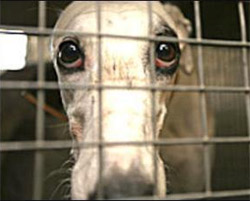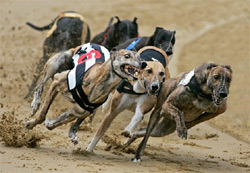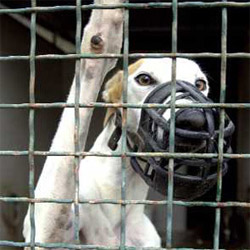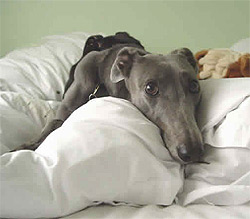Fair Treatment for Racing Greyhounds: Don't bet on it
An evening at the Greyhound races can seem like a fun idea until you learn about the neglectful treatment most racing Greyhounds suffer. They don't go home to a cosy bed, love and a family. And most don't retire in a comfortable home once their working life is over, unless a charity steps in. Only a very small proportion of ex-racers will find loving homes to live out their final years.

The working life of a racing Greyhound is tough, lonely and painful. Even those dogs who are well cared for risk injuries all the time. We feel sure that if more people realised what they were supporting they simply would not go.
These intelligent and loving animals are bred and used in an industry that only cares about punters and profits. Bitches are incessantly bred from until they are of no more use. Injured or under-performing racing dogs and those at the end of their careers are 'economically' disposed of. No caring hand or painless injection for them.
The life of most racing Greyhounds is one of pain and suffering with a traumatic end. Many are forced to race with injuries and are given Viagra or cocaine to improve their racing speed. Many are caged, muzzled and starved to make them run faster on race day. Racing is not a pleasurable activity for them. They are not having fun!
 Regulations
Regulations
The Greyhound racing industry is self-regulated. So whose is able to help?
Dogs Trust explains that "The Welfare of Racing Greyhound Regulations (2010) were brought in after huge pressure from charities, MPs, media and the public to ensure that the industry ‘cleaned up its act’ and that the welfare of the dogs involved was better protected."
However, this legislation only 'protects' dogs whilst on the track, accounting for less than 10% of their lives. There was still no protection for Greyhounds during breeding, kennelling, transportation and retirement.
 Dogs Trust conducted an in-depth investigation to expose the conditions of greyhound trainers’ kennels. The findings report was published in June 2015, laying bare the extremely poor conditions that some greyhounds are kept in for as much as 95% of their time.
Dogs Trust conducted an in-depth investigation to expose the conditions of greyhound trainers’ kennels. The findings report was published in June 2015, laying bare the extremely poor conditions that some greyhounds are kept in for as much as 95% of their time.
It was clear that the regulations needed to be extended to the trainers and breeders facilities. "These out of sight premises, where Greyhounds spend the majority of their time will continue to evade scrutiny if this void is not filled." said Dogs Trust. "Clear guidelines need to be laid down in the form of regulation. Breeding and boarding establishments have legislation and regulations to cover them with independent inspections taking place; we see no reason why Greyhound kennels should continue to evade legislative scrutiny."
Is the Government finally listening?
Hopefully! It seems that the government has finally listened and responded to calls for a review.
In a press release this week, Dogs Trust announced that a review is planned, hopefully leading to a tightening of existing regulations for racing dogs. The Department for Environment, Food and Rural Affairs (Defra) has launched a consultation into the effectiveness of the legislation introduced in 2010 that was supposed to protect racing greyhounds.
Paula Boyden, Dogs Trust Veterinary Director, says:
“It is important the Government uses this review as an opportunity to update the regulations for the protection and enhancement of the health, welfare and care of all racing greyhounds throughout their lives.”
 What we can do
What we can do
Greyhound racing is still a hugely popular 'sport' but how many people really know the truth behind the industry?
The easiest way for us, the general public, to help is to avoid greyhound racing, avoid betting on this kind of sport and to explain why to anyone who will listen. Greyhounds rely on us to be their voice. Share this information. There will be people who simply don't realise what really goes on in the life of a Greyhound.
You can of course also consider adopting an ex-racing Greyhound. Find out more here Greyhounds Make Fantastic Pets.
By Jenny Prevel
© D for Dog www.dfordog.co.uk
This article belongs strictly to D for Dog and we do not authorise the copying of all or any part of it.

These rules MUST be changed as should the way they are raced to save on injuries to their legs and joints! Racing in a straight line would be much better or even alternating the directions of racing would even make a great and good difference. We owe it to these wonderful creatures to give them a second life for the bettering! Please think of them when getting a dog, you won't be disappointed! They need you to love them like a dog should be loved!
This is simply a totally false statement that most greyhounds suffer. I know first hand how the dogs are looked after!
The thought of racing greyhounds on broken legs is really just people being so careless, these creatures should be treated like any other dog would.
4 months ago after being a volunteer walker , I actually adopted an ex racing Greyhound . She is 8 years old . So when I collected her nails long , full of flees , thin underweight , worms in excrement . I cannot believe how absolutely wonderful Girl . Day 1. We bonded . So grateful for cuddling , following me . I'd only had Gsd but my greyhound I can't praise enough .